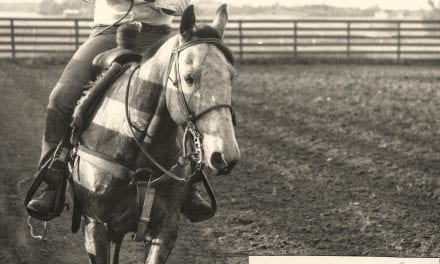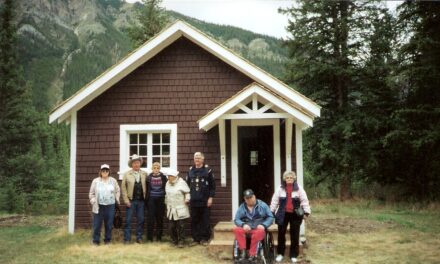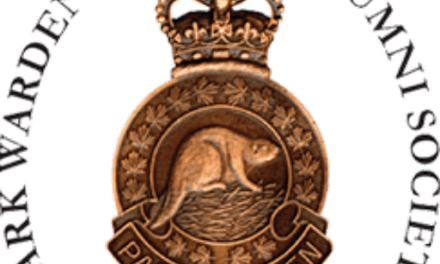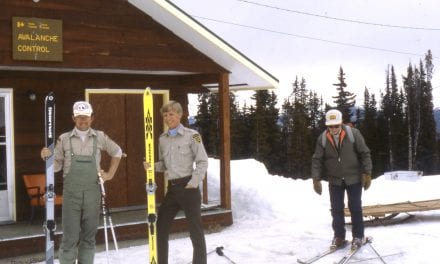Rod: That’s nice to see after a period of less horse use and now there is more incentive to use horses and more need for trained horses.
Rod: What about your work with other groups too? Like the military and the provincial people?
Rick: Yeah. We were approached by the military (Department of National Defense) a few years ago and it was the Special Operations Forces that were taking climbing courses through Parks Canada already. Then they heard about the horse program and they thought they could use this training for search and rescue, overseas deployments and things like that. So we set up a course for them and they usually come every year, or every two years, whichever works for them. They will be here for two weeks. They pay per person per day and that includes their accommodations, the training and the use of the horses and equipment. So it helps the ranch (financially) in the long run. We also winter horses for Alberta Parks with the provincial government. And we contract one 3-day horse school for them in the spring. And they pay as well so that helps foot the bills at the ranch.
Fish & Wildlife and the R.C.M.P. have used the ranch for different courses here. So it isn’t strictly Parks Canada staff. Anyone that is in the federal or provincial government that needs some horsemanship training or support.
Rod: That is pretty dynamic with that kind of an outreach. You’ve kind of really broadened the whole ranch operation in that regard and in your time here.
Rick: Well, I am sure that every ranch manager that has been here has had different things that the times have dictated to them and you just go with the flow. You have to learn to be pretty versatile here because you are not sure what the next e-mail is going to bring you. You have to be ready and prepared for things like the bison project, etc. You know, we heard about it for years and then all of a sudden “bang” we are going (with the bison project). And so, it is time to get your hands out of your pockets and get….
Rod: Well you certainly have to be adaptable and able to be able to manage many facets of the ranch operations here besides the horses themselves.
Rod: Back to the horses again. Over your time here you have had a change from raising horses and actually having had a brood herd operation here on the ranch to actually now purchasing horses. An attempt was made for a while to purchase horses that were already green broke and then the horse trainers would finish them off. That has changed a bit too eh?
Rick: The breeding program was over when I got here. I think it had kind of came to an end after Johnny & Marie Nylund’s time on the ranch and they could tell you more about the “why’s and why-nots”. I always heard it was a financial decision and that it was cheaper to buy younger horses than it was to operate a brood herd and stallions and all this kind of stuff but I don’t know for sure. Johnny and Marie could answer that a lot more than I could. (John Nylund later clarified that he retired from the Ya Ha Tinda Ranch in March of 2003. And after he retired Banff Field Unit undertook a financial review of the brood herd program and made the business decision to no longer financially support the program. In April of 2003, Park Warden Bradley Bischoff became Interim Ya Ha Tinda Ranch Manager and was assigned the task to selling off and dispersing the broodmares.)
Rick: When we got here we still had a stallion and a couple of mares that we took to the Bar U. They were part of Ken Pigeon’s display down there (at the Bar U National Historic Site) and we had quite a few colts and two-year olds from that program that we trained and they are still active in the parks now and have been for years. We started out thinking we’d buy two and three year olds that were unbroke but it didn’t take us too long into our program to learn that we couldn’t find many that other people hadn’t tried to start and the reason that they were at the (horse) sales was because they had tried and failed and those horses came with a lot of baggage.
As it was we were lucky if 50 percent of them worked out to what we wanted for Parks Canada horses. And so, we decided about three years ago to buy weanlings, bring them home, halter break them, trim their feet and everything and bring them in the barn for the first year and get them going good and then as two-year olds we’ll ride them half a dozen times and turn them out again. At three-year olds they come into the barn and they begin a two-year training program that will use them in schools and on backcountry trips with different crews and this kind of thing and get them used to other people. By (the time they are) five years old we are hoping they are ready to go to the parks. I think it is going to be a whole lot more successful because these horses have been started from the ground up with our program and the same program we are teaching everybody who comes to school here. The two barn bosses teach as well. So all of us are on the same program, and the horses are on that program and the people coming up are on that program and it works. I think it (the new program) is going to work gangbusters.
Rod: That really seems to make sense because often at auctions you never know what you are going to get or what experiences these horses have had. Doing it from the ground up seems to make sense.
Rod: You still attend auctions and still purchase some of these young horses whenever you can. What is your current population of horses here?
Rick: Well, we have about 60 patrol horses wintering over, and then we have got about 11 three-year old colts that are being trained, and we have five 2-year olds and seven yearlings. And then we have a few other horses that we have bought in odd places here and there at the odd sale.
Jean: And the reason for that is a lot of the older patrol horses in Jasper and Banff were retired all at once and we had a shortage of broke horses so until the three years olds are ready to go we bought a few broke horses and the boys (the horse trainers) have worked with them to makes sure they are ready to go to the park, but they are just kind of “filler inners”.
Rod: Well, it sounds like a real organized situation where it takes a fair bit of time and thought to keep track of what your needs are but also what parks needs are. To have them on a regular cycle like that so that you can supply the horses as required.
Rick: Yup. Now, I think that this (horse program) is going to be a lot simpler….two years from now will be the outcome for us when these three-year olds go to the parks and we are completely on our own program with the weanlings. Then we won’t have to go through this buying outside horses and get disappointed a lot of times. I don’t know if people really lie to you but they definitely don’t know what they are taking about quite often when they tell you how great some of these horses are. And then you bring them home and find out….“Wait a second that’s not the same horse I was talking to him about.” (laughs)
Rod: That is a common concern at auctions from the little bit I know about it.
Rod: What about life at the ranch itself? You’ve met all kinds of people. There are lots of researchers on the ranch on a pretty regular basis and those people come and go and contribute to the ecological knowledge of the area. I guess that is primarily what they are here for.
Rick: Yeah.
Rod: Fire management is a part of operations….I guess you get involved with that a little bit do you?
Rick: A little bit. Basically, what we do is to try to stay out of their way when it comes to fire management because we are not trained for that. The researchers that we get here are in a partnership between the University of Alberta, the University of Montana and Parks Canada. We get the benefit of all the knowledge they gain through the research. They are a great bunch of kids, a good bunch for our program too because they use horses for a lot of it especially for this last elk project. It’s good for us as we work on our training skills working with them and they are using horses and we can get the young horses used to strangers a lot quicker. All and all, it has worked out very well.
Rod: It benefits everyone concerned then eh?
Jean: It does. The odd time when they have to go find a (elk) collar and they need to go across the river or up over the Dogrib, the boys will take them and guide them basically through all of that. So, the colts are getting valuable experience as well.
Rod: Crossing the river and all those kinds of things.
Rick: Even with some of these horses we have got so that we can shoot off of three or four of them. We had to dart elk as part of the research program so that was something we had never done before and it was fun to teach colts to handle this. We’d go out there and work with it. It has been a real good partnership.
Rod: It works well for both sides.
Rod: Can you give us a few details about the fire Ian Pengelly started in a controlled burn?
Rick: Previous to he planned prescribed burn in 2009, we logged around the ranch yard as a fuel break. Every precaution was taken to avoid any fire damage to the yard, buildings and livestock. And the conditions were right to start the fire. But the wind and weather took an unexpected turn and they lost control for awhile. That was a scary couple of days, but they eventually got it under control with the Ya Ha Tinda Ranch still intact. We’ll never forget it and certainly learned a lot from it.
Rod: What about the campground? We’ve talked about that a little bit and how that has evolved. Do you have a pretty good relationship with the Friends of the Eastern Slopes and the operation of the campground? (The Friends of the Eastern Slopes Association was formed in 1994. FOESA manages the care and maintenance of the Bighorn Campground on the Ya Ha Tinda Ranch under a Memorandum of Understanding with Parks Canada Agency. This group of dedicated volunteers has made significant contributions not only to the campground on the Ya Ha Tinda but also to equestrian campgrounds and provides input into recreational use of the Eastern Slopes of Alberta.)
Rick: Yeah, we do have a great relationship with them and it has been going on for a long time through Johnny (Nylund) and Ken Pigeon and ever since they started. The Friends are a huge asset as they take care of the day-to-day maintenance of the washrooms, gravelling roads, and building high lines and tie stalls. They even have a “host” that helps people with trail conditions and advice on where to go and what to see and things like that. The public being able to use the ranch here has always been welcome. They have always been able to hunt on most areas of the ranch. We keep one area, our pastures, where they are not allowed in and they have been good about that. There are a lot of people who love to come out and ride. Parks Canada has never charged anybody for this and for the use of the land. And so, to have the “Friends” there and through donations they tend to maintenance on the trails and in the campground and all that has been fantastic. We get an average of 9000 horse nights a year down at the campground and that is all walks of life …people from as far away as Vancouver Island. Mostly they are Albertans but we’ve had people from Quebec and Ontario with their horse trailers and their horses. I think it is a really good thing and it is a really good thing for Parks to keep it something that people can afford to do and enjoy their horses and camp with their families.
Jean: There are not many places where you can go and camp with your horses and have them right at your camp and be able to ride incredible country without the sound of ATVs. You can go up to the Hummingbird or north on the Forestry Trunk Road where there is lots of beautiful riding but you are going to hear that noise and so people love to come here. What we are experiencing now is that we are starting to get a few more hikers…. non-horse users because they can get out here and just enjoy the peace and quiet and not have that noise…or $32 per night camping fees somewhere.
Rod: Well it is a unique place. It’s nice that there is this place that is able to operate without a campground attendant or costing money. You’ve got to give full credit to the Friends of the Eastern Slopes Association.
Jean: Yeah, for the most part there is major appreciation and respect by the users. We rarely, rarely have an issue with anybody that is careless.
Rod: Are the public still welcome to come to the ranch to look at the Historic Display?
Rick: Yeah. We try to do it at the end of our work day and we try to post it so that people can come up as a group so that we are not having three or four people wandering in every hour. But at the end of the day, the colts are out of the barn so I am not worried about someone reaching in and petting one and accidentally getting kicked or stepped on. And the barns are clean and we can take them around and tell them the history of the place and show them some of the buildings and take them through the barns. And they appreciate it I think because most of them don’t really realize how valuable the horses are to Parks Canada and how much of a job this whole ranch is and not just a place to come camping but a place that is actually a working horse ranch. It is nice for the public to learn what value the horse program is to parks.
Jean: And we will do special group tours too. Like the Rotary Club will have a bunch of exchange people from somewhere and they will phone ahead and we will set up a time and that can be anytime….whatever is convenient for them and for us. And, you know, church groups, the “Y” Camp. (The “Y” camp is operated by the YMCA during the summer months. The camp is located east of the Ya Ha Tinda Ranch east gate. Formerly owned by the Walker family and operated as Frontier Town with small rustic cabins with horse guiding facilities.) We already have their dates throughout this summer when they will bring their kids up for a tour. So, we do accommodate special groups as well.
Rick: The historic display is all thanks to Marie (Nylund). She was the one who set up the Historic Exhibit. (Tours of the ranch buildings had been in place during Ken & Deb Pigeon’s years at the ranch. Marie volunteered to conduct the tours whenever possible and schedule the tours around the day-today operations of the ranch. In 1999, the log granary was no longer needed Marie Nylund, with permission from Chief Wardens Jacobson and Haney, was granted permission to display photos, artifacts and items of interest. The exhibit provided a source of entertainment and added some flavour to the visitor experience during the tours.)
Jean: And I think it is important…. the public appreciation. In many years in the past, sometimes it was kept quiet and hush-hush and they didn’t want anybody to know about the Ya Ha Tinda but we really need that public appreciation and public support. The public does appreciate it so much when you give them a tour.
Rick: Their eyes are this big (indicating) and they smile from ear-to-ear. You could easily sit down with them all evening and as long as you are willing to talk to them and show them things they’d be willing to stick around. When we first came here…and Marie had already started this…Jean and I started doing these tours and it was surprising to us how much people were interested in the ranch and the respect that they had for the ranch and the horse program and that kind of stuff. It was really interesting.
Rod: Do the Friends of the Eastern Slopes have special events during the summer?
Rick: Oh yeah, they have a poker rallies and different things to raise money. They not only look after the Bighorn Campground but six or seven other campgrounds. We all go down and join in and have some fun.
Rod: What about some different kind of happenings on the ranch during your time here. I know that this is where people have landed an aircraft on the fields out front. Have you had any particularly interesting wildlife experiences with cougars or bears or anything?
Rick: Well, in the spring it is always quite busy with the bears with the elk calving and the bears around and that. It is always a concern, but we have never – touch wood – had a problem with them yet. They still remain pretty wild. Cats (cougars) – it is always a controversy as to how many there are here. We know there are lots but how many (is difficult to say) because they are so elusive you know…it is really hard. You pick them up on game cameras and that sort of thing but rarely are you lucky enough to see one. A few people incidents occur every year. And then horses get lost or run away and people fall off and hurt themselves. But between the Friends of the Eastern Slopes and others….people really help each other. We are here for response to accidents and things like that. And there are been some major accidents but Parks Canada has been good with their public safety people coming out and helping people out here. Even Jean….
Rod: Do you want to tell that story, Jean?
Jean: Well….it’s not really much of a story…I mean…my horse ran away with me and he tripped and stumbled and I fell off. I got a plate and 11 screws in my shoulder. But I was riding with three of the best guys that I could have been riding with….and that was Ian Pengelly, Cliff White and Rick Smith. And within 45 minutes my newest best friend was Lisa Poulson in the helicopter. Yeah, I could not believe how quick the response was…and always has been. When we have major accidents we get a hold of dispatch, public safety and they are here so fast, it’s incredible.
We have had so many accidents. I said to Rick, we could sit on the deck and tell stories all day long about that. But their (Parks) response has been phenomenal. The by-standers that have roared up here to report what they have seen – like someone going over Bighorn Falls and by-standers actually rescuing those people themselves. You know it’s been phenomenal how much help you get up here. But now with technology and how much that has changed we’re not so much first response because they have got the SPOT communication. We’ll be sitting here and all of a sudden STARS will come in. (In the past) it was usually a case of you’d see someone come roaring up that road and you’d think that there has been an accident, whereas now, people are dealing with it themselves with their own technology. It is pretty amazing.
Rod: As you said before, the ranch is not as isolated as it once was (communication wise).
Rod: Can you tell us about the bison program? Are you enjoying the bison that are now on the ranch?




Rick Smith please contact me, scot hall